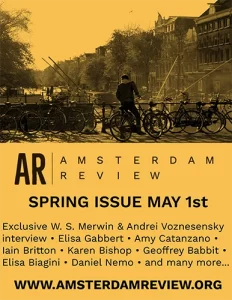The Bad Version – Winter 2012
Volume 1 Number 2
Winter 2012
Quarterly
Shannon Smith
The Bad Version is a new literary magazine, and this is only its second issue. While showing many signs of promise, the magazine is clearly still suffering some growing pains. The mission statement on their website says that the name of the journal “comes from the collaborative art of screenwriting, where the first attempt at a scene, that wild idea that gets the process going, is called a ‘bad version.’ Likewise, this magazine is dedicated to beginnings: to pieces that are taking risks, trying to broach new ideas, experimenting with new forms, starting new conversations.”
The Bad Version is a new literary magazine, and this is only its second issue. While showing many signs of promise, the magazine is clearly still suffering some growing pains. The mission statement on their website says that the name of the journal “comes from the collaborative art of screenwriting, where the first attempt at a scene, that wild idea that gets the process going, is called a ‘bad version.’ Likewise, this magazine is dedicated to beginnings: to pieces that are taking risks, trying to broach new ideas, experimenting with new forms, starting new conversations.”
Unfortunately, it seems that a few too many pieces in the journal are still heavily routed in that “first attempt at a scene”—that is, they seem rough and unpolished. This is especially applicable to the essays, which can be meandering and extremely verbose, often suffering from the lack of clear form and direction. I do not think this roughness stems so much from their “new forms” or “new ideas,” so much as the authors are clearly excited about what they have to say, invested in it, have interesting ideas, but have not fully honed the expression of their arguments in a long form.
What’s really interesting about The Bad Version, however, are the short commentary pieces after each selection. It seems that each author in the journal was asked to write a response to someone else’s piece. These short pieces are thoroughly interesting, and they provide idiosyncratic takes on each piece in the journal as well as starting a conversation about the piece. The responses note favorite details that move the stories along and moments that essays hinge on as well as help to elucidate obscured passages or endings. Utilizing these short responses is a courageous idea that will lead into the brave conversations The Bad Version seems to want its pieces to start.
Out of the five essays in this issue, Sanders I. Bernstein’s “The Quest for Fantasy’s Power: Muggles, Millennials, Magicians, and Everybody Else” stood out the most. While the essay does suffer from some problems of form, it provides an interesting exploration of how Harry Potter could possibly have managed to unite a generation that is otherwise dependent on and defined by niches.
Daniel Howell’s “Martha Ruth Marcy May Bekorah Marlene,” one of the more succinct and direct essays in the journal, offers a nice exploration of cults, with a personalized touch, as he looks at a family member’s participation in a group called “The Community.” Howell’s writing veers skillfully between observations, abstractions, and investigations. These ideas come together quite well, not scattered and all over the map.
As for the fiction, an excerpt from Jesse Baron’s The World Islands and David Rice’s “Ainsworth Gym” were my favorites; though, both suffer from having characters that seem more like shadows of characters—characters who are defined more by what the reader brings to their conception of the type of person being written about than what is on the page. That, though, is a fleeting and momentary problem in the stories; it’s a problem that’s hard to define because both authors are playing with archetypes but utilizing them as well. Barron’s piece, especially, provides insight into expat life in Dubai, while at other times being a more conventional story. Rice’s piece evokes modern horror tropes and then attempts to subvert them—sort of—because he still needs these tropes for the story to succeed.
While I think the quality of writing in The Bad Version is promising but not exceptional, the journal does have a great layout and design. The spacing of its font, where the writing zooms almost all the way across the page, comes across as a combination of a zine and journal. The cover art and drawings scattered throughout lend this issue the same feel, and perhaps that is really the most apt summary of The Bad Version: it’s more akin to a zine than a literary journal, and its homemade feel is something to admire.
[thebadversion.com]




